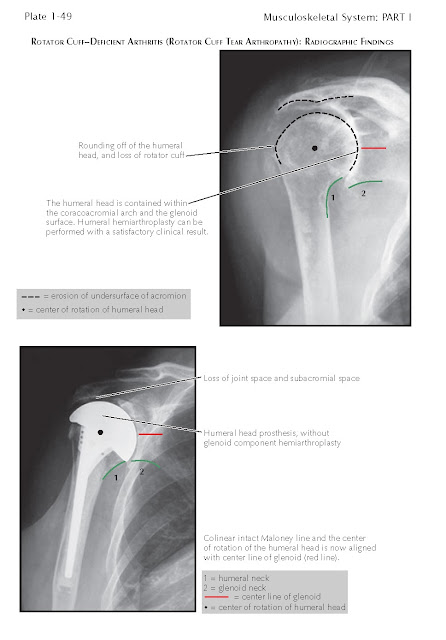Rotator Cuff–Deficient
Arthritis (Rotator Cuff Tear Arthropathy)
In some cases of arthritis there is
severe damage to the rotator cuff along with arthritic changes of the articular
surfaces of the joint. This can occur in severe cases of rheumatoid arthritis,
in cases of crystalline arthropathy, or in patients with large chronic rotator
cuff tears. These diseases result in severe erosive arthritis and superior
migration of the humeral head. This often is associated with erosion and bone
loss along the superior portion of the joint (see Plate 1-50). When these
patients come to surgery, there is often little or no rotator cuff tissue
surrounding the humeral head.
Patients with less severe rotator
cuff–deficient arthritis have superior migration of the humeral head, yet the
humeral head is still stable and contained within an intact coracoacromial
arch. When the humeral head is contained within the coracoacromial arch and
glenoid surface, along with sufficient remaining rotator cuff tissue to
maintain a stable fulcrum for rotation of the humeral head within the intact
coracoacromial arch, a humeral hemiarthroplasty can be performed with a sat-
isfactory clinical result.
In these patients, the physical examination
will generally demonstrate the ability to elevate the arm to at least 90
degrees and the humeral head remains contained under the coracoacromial arch.
The clinical findings of superior escape and pseudoparalysis of the shoulder
are not found (see Plate 1-48). The shoulder examination is more consistent
with part B on Plate 1-40 than the examination seen on part A in Plate 1-40 or
the examination seen on Plate 1-48. In patients with rotator cuff–deficient
arthritis, a contained humeral head, and active elevation to 90 degrees,
hemiarthroplasty provides a more simple surgery than reverse total shoulder
replacement. The patients in this category of rotator cuff–deficient arthritis
generally achieve good pain relief and moderate improvement in shoulder
function above shoulder level. In patients who are good candidates for
hemiarthroplasty it is important to preserve all parts of the rotator cuff that
are intact at the time of surgery and to provide a postoperative rehabilitation
program to strengthen those parts of the rotator cuff and deltoid that remain.
It is also important in this group of patients to preserve the mechanical
integrity of the coracoacromial arch.
When rotator cuff deficient arthritis
is associated with loss of the containment mechanism of the humeral head within
the coracoacromial arch, then the patient loses a fulcrum to rotate the humeral
head and the result is termed pseudoparalysis of the shoulder. When
these conditions occur in the older and less active patient, the best treatment
is reverse shoulder arthroplasty. Physical findings, consistent with superior
escape of the humeral head and pseudoparalytic shoulder, include a relatively
normal contour to the anterior aspect of the shoulder with the arm in the
resting position. With attempted active elevation of the shoulder, there is a
superior shift of the humeral head and a prominence of the humeral head
anteriorly. This is associated with lack of the ability to forward flex the arm
as well as lack of active external rotation (loss of the superior and posterior
parts of the rotator cuff). This lack of function is consistent with pseudoparalytic
shoulder. Classic findings of rotator cuff tear arthropathy are difficulty with
active elevation of the shoulder, marked degenerative changes and collapse of
the humeral head, superior migration of the humeral head, and associated severe
rotator cuff deficiency and subchondral cyst formation in the humeral head.
Reverse total shoulder arthroplasty
means that the components are designed to be opposite to the normal anatomy.
The convex surface is on the glenoid side, and the concave surface is on the humeral
side. This causes a semi-constrained joint, resulting in a fixed center of
rotation, thereby substituting for the function of the rotator cuff. When there
is loss of function of the coracoacromial arch to contain the superiorly
migrated humeral head and there is superior escape of the humeral head and
resultant pseudoparalysis of the shoulder, a hemiarthroplasty will not provide
any improvement of function. The reverse arthroplasty enforces a fixed fulcrum
for rotation of the humeral component around the glenoid component and therefore
partially substitutes for the containment function of the rotator cuff with the
center of the humeral head within the glenoid. With a reverse total shoulder
replacement the center of rotation is shifted from the center of the humeral
head in the normal shoulder anatomy to the center of the spherical glenoid
component. This results in a large medial shift in the center of rotation. A
large medial shift in the center of rotation results in a more than doubling of
the moment arm of the deltoid, thereby improving its mechanical advantage and
ability to elevate the arm. In addition, medi- alization of the center of
rotation to the interface between the glenoid bone and its surface contact with
the glenoid component minimizes the moment arm for the forces around the
glenoid component, resulting in a decrease in the sheer forces around this
component. This results in a very low incidence of component failure owing to
the mechanical stresses at this bone-prosthetic interface. The reverse total
shoulder replacement does dramatically improve the patient’s ability to elevate
the arm as a result of these mechanical features. The reverse total shoulder
does not provide better rotational function, and the best results of reverse
total shoulder arthroplasty are seen in patients with some posterior rotator
cuff function before surgery (e.g., an intact teres minor tendon). Patients
with some external rotation function will often achieve near full elevation of
the shoulder after reverse total shoulder replacement. Those patients without
any external rotation function before surgery will generally get less
improvement with reverse replacement but generally will get shoulder-level
elevation. Patients with no posterior cuff function may benefit from muscle
transfers performed a the time of the reverse total shoulder arthroplasty.







